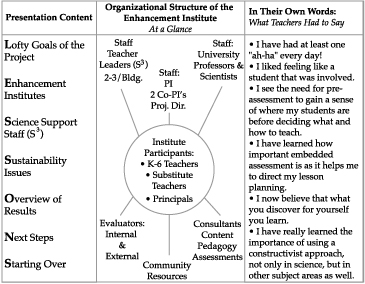 |
|
|
Poster Presentation Full Text: Wanted by NSF: Strategic Change Pioneers The Midland Public Schools Science Resources Center Answered the Call Poster presentations are composed in four parts:
|
|

The Midland Public Schools' plan to systematically change elementary science began in 1989 when a team comprised of the superintendent, coordinator of science and an elementary teacher, attended the first National Science Resources Center's (NSRC) week-long Leadership Institute.
With funds provided by a local family foundation, the district's Science Resources Center was established. We bought an eclectic mix of nationally validated modular units (kits) that were aligned with state and local standards and benchmarks. These "kits" formed the core of our k-6 science program and would be instrumental in shifting from the traditional "teaching as telling," textbook approach to "inquiry-based science."
We learned that systemic change doesn't happen overnight. It takes a long time, much longer than we ever envisioned. It also will not happen by merely providing teachers with the "stuff" for hands-on/minds-on science, even when you provide district level technical support and expertise.
On the other hand, what did happen was teachers saw student interest in science soar and they clamored to learn more. Teachers charged with guiding students' learning inquiry skills discovered that they were not secure in their own knowledge of science concepts, strategies and diverse forms of assessments for understanding. A comprehensive professional development program for staff would be essential. Our challenge was figuring out how to make it happen.
Lofty Goals
Having the infrastructure already in place to reform science, we sought and received an NSF 3-year grant for staff development in 1995.
The goals of the project were to:
Science Support Staff (S3)
2-3 lead teachers were selected to represent each of our 12 elementary schools. They would go on to be science mentors and resource people in their building and also serve as liaisons to the district elementary science teacher consultant and science coordinator. They would form the backbone of the professional development institutes and the sustainability initiatives.
S3's (cubes for short) received intensive and extensive professional development during the summer and school year sessions, totaling over 400 hours each. Most are still serving in this capacity after 6 years, and teaching their regular classroom schedules.
During the summer and calendar year institutes, they facilitated all small group activities, provided one-on-one and other technical assistance to colleagues in their home schools. They also served as mentors to colleagues as they implemented inquiry-based teaching/learning and assessment strategies, with students.
The S3's have played a key role in getting staff members to participate in the institutes and other professional development opportunities through the years. They work closely with principals in incorporating these strategies into their school improvement plans.
As fulltime classroom teachers of all subjects, over time, they have weaved their "NSF strategies" into the other disciplines. This influence is now seen districtwide and in areas such as mathematics, language arts and social studies.
Prior to the NSF Institutes, all staff development on our "kits" was led by either the district's teacher consultant or this science coordinator. Now, these workshops are led by the S3's. They also provide building support, especially important for new teachers or teachers changing grade levels.
( BACK TO POSTER | BACK TO TOP )
Where We Are
After a decade of this journey to systemically reform the teaching and learning of science in our district, we have crossed many thresholds (textbook kits substantive PD). The sustainability threshold is probably the most challenging and arguably the most important. It represents the brass ring - the biggest payoff to all students and districts.
All of the key elements and infrastructure are in place, though in varying degrees:
Where We Need To Go
Overview of Results
The district continues to be committed to investigative science. The vision articulated for the LSC has become a reality, in process, for most participants. All k-6 students receive almost daily science instruction . The experiential nature of the professional development has influenced the way teachers think about teaching and learning. There is a much greater focus, by teachers, on student learning rather than what the teacher is doing. There is also greater emphasis on pre-and embedded assessments to guide instruction. The results of post-assessments are shared with teachers at the next grade in the curriculum spiral (i.e. 2nd grade results on the unit on Plants are shared with 4th grade teachers teaching the Plant or Ecology unit at the next level). There has been a steady increase in state assessment performance across the district.
Substitute (guest) teachers who participated are more knowledgeable about the program. They provide continuity and less disruption to the program planned by the teacher.
Parent participants provide support in nontraditional ways to staff. They hold parent-to-parent meetings & share information on how to support classroom instruction at home. They recruit volunteers and inventory the science "kits." Parents conduct clinical interviews of students. They also organize engaging science nights
( BACK TO POSTER | BACK TO TOP )
Starting Over
So, if we had to do it again, some things would be the same, such as:
The following are the primary differences:
( BACK TO POSTER | BACK TO TOP )
THIS POSTER WAS PREPARED BY:
Sarah Lindsey of the Elementary Science
Teacher Enhancement Institute project.
( BACK TO POSTER | BACK TO TOP )
|